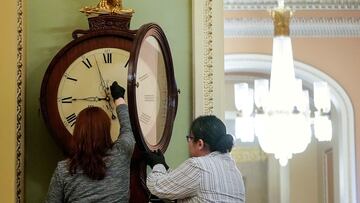Time change U.S. 2025: do the clocks go forward or back in November? Do you get more or less sleep?
Daylight Saving Time ends in the United States in the early hours of Sunday, November 2, 2025 - and there’s still some confusion.

Daylight Saving Time 2025 is about to end in the United States. Twice a year, most Americans have to change their clocks - in March and November.
Daylight Saving Time begins in the country on the second Sunday of March. This year, the change took place on Sunday, March 9, at 2 a.m. Meanwhile, Daylight Saving Time ends on the first Sunday in November, when Standard Time returns.
For 2025, the second time change of the year takes place on Sunday, November 2, at 2 a.m. But are the clocks going forward or backward?
U.S. time change 2025: Do the clocks go forward or back in Nov.?
When Daylight Saving Time began in March, the clock was moved forward one hour. So to return to Standard Time, the clock must be moved back an hour during the early hours of Sunday, November 2.
In most cases, you don’t have to worry about changing your clocks manually, as the majority of electronic devices, such as smartphones, tablets and computers, automatically make the switch.
When will the time change again? Daylight Saving Time starts on this date in 2026
Standard Time will end on the second Sunday of March next year. Daylight Saving Time will begin on March 8, 2026.
Daylight Saving Time 2026 will then end on November 1 next year.
If you live in these areas of the U.S., your clock won’t change in November
In some parts of the U.S., Daylight Saving Time does not exist, as they maintain Standard Time all year round.
The state of Hawaii and most of Arizona do not observe Daylight Saving Time, so they do not set clocks forward or backward. Other U.S. territories in the Pacific and Caribbean Sea, such as Puerto Rico, the Virgin Islands, the Northern Mariana Islands, Guam and American Samoa, also do not make the change.
Arizona used Daylight Saving Time beginning in 1918, but decided to opt out of it in 1968. Although the state maintains Standard Time year-round, the Navajo Nation, located in the northeast of the state, does observe Daylight Saving Time, making the change twice a year.
Related stories
Get your game on! Whether you’re into NFL touchdowns, NBA buzzer-beaters, world-class soccer goals, or MLB home runs, our app has it all.
Dive into live coverage, expert insights, breaking news, exclusive videos, and more – plus, stay updated on the latest in current affairs and entertainment. Download now for all-access coverage, right at your fingertips – anytime, anywhere.


Complete your personal details to comment